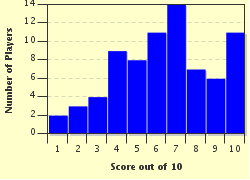Quiz Answer Key and Fun Facts
1. In England, an activity known as 'swan upping' takes places every year on the River Thames. It sounds like people just swanning around but actually has an important purpose - what?
2. The mute swan is found around the world and has a distinctive habit of curving its neck back onto its body and fluffing up its wings when threatened. What is the (ironically) musical name given to this aggressive posture?
3. The whooper swan, a large white bird with a predominantly yellow bill, has breeding grounds across northern Europe and Asia. Which country included a whooper swan as part of the national design on its one Euro coin?
4. Australian black swans are distinctive members of the swan family due to their black plumage and red bill. However, on closer inspection, which of a black swan's feathers are actually white?
5. Bewick's swan and the whistling swan are two closely related sub-species of tundra swan. These birds are commonly found in the same colonies and often interbreed.
6. Which species of swan is native to North America and was extensively hunted in the 19th century for its meat, feathers and skin?
7. The coscoroba swan, a large white bird with black wingtips and a red beak, more closely resembles a goose than other members of the swan family. On which continent would you find its native habitat?
8. Cygnus melancoryphus is native to South America and is a slightly odd looking bird with the white body typical of northern-hemisphere swans coupled with a black neck and head more like that of the black swan from Australia. By what common name is this swan known?
9. Like many birds, swans existed long before humans became a dominant species on Earth. Several extinct species have been identified from their fossil record, including Cygnus falconeri, an aptly named large swan that lived around the Mediterranean during the Pleistocene epoch. What common name has been given to this long-lost swan?
10. Several species of swan have an additional anatomical feature known as a 'tracheal loop', which causes these birds to utter a series of long, drawn-out notes if their lungs collapse. This phenomenon has been put forward as a potential explanation for which term?
Source: Author
Fifiona81
This quiz was reviewed by FunTrivia editor
guitargoddess before going online.
Any errors found in FunTrivia content are routinely corrected through our feedback system.

